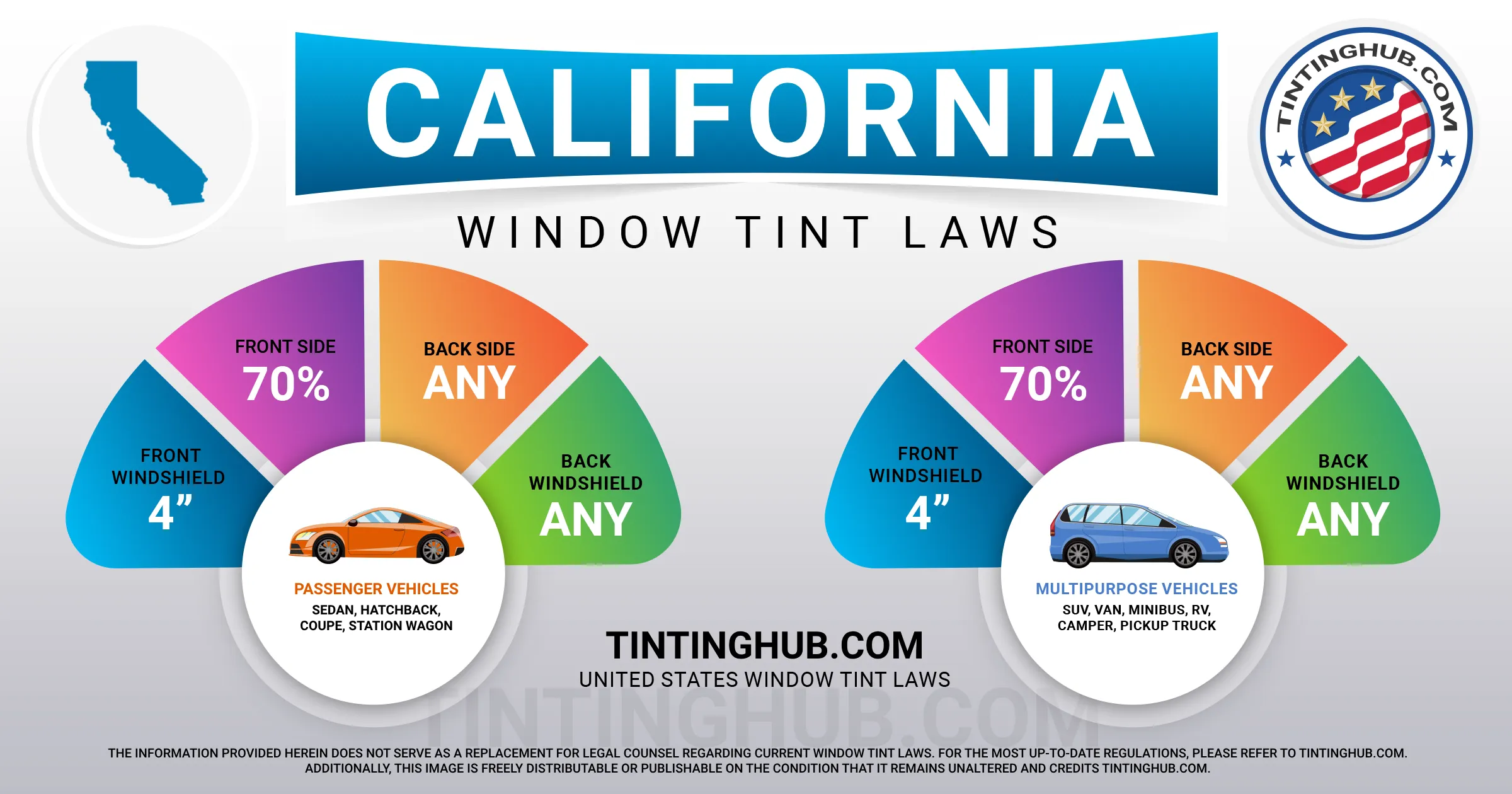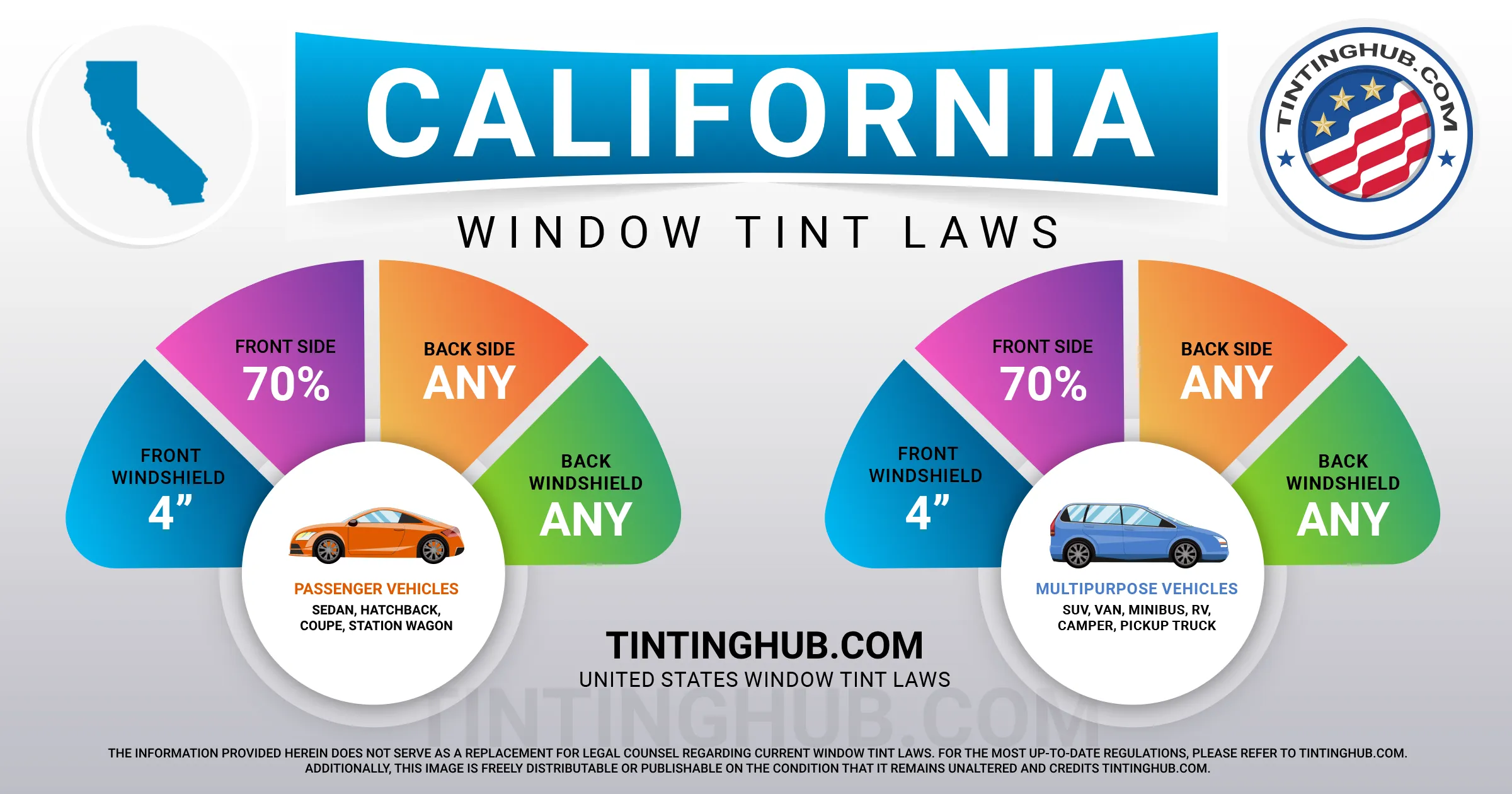California Window Tint Laws (Last Update 2024)

Understanding California’s window tint laws is crucial for vehicle owners who want to comply with regulations while enjoying the benefits of window tinting. This comprehensive guide covers everything you need to know about the state’s tinting laws as of 2024, ensuring your vehicle meets all legal requirements.
Legislative Nuances Across California
California has established general guidelines for window tinting, but it’s important to note that local interpretations may introduce subtle variations. For definitive clarity, we recommend consulting with local Department of Motor Vehicles (DMV) branches or law enforcement agencies.

VLT (Visible Light Transmission) Requirements
Visible Light Transmission (VLT) is a measure of how much light a window tint film allows to pass through. California’s VLT requirements vary depending on the type of vehicle, with specific percentages for different windows. For a deeper understanding of VLT and how it affects your vehicle, see our detailed guide on Window Tinting Percent.
Sedans
- Windshield: Non-reflective tint is allowed on the top 4 inches.
- Front Side Windows: Must allow more than 70% of light in (30% tint darkness allowed).
- Back Side Windows: Any level of tint darkness is allowed.
- Rear Window: Any darkness can be used.
SUVs and Vans
- Windshield: Non-reflective tint is permitted on the top 4 inches.
- Front Side Windows: Aftermarket film must allow more than 88% of light in or have a minimum of 70% VLT if combined with factory-tinted windows.
- Back Side Windows: Any level of tint darkness is permissible.
- Rear Window: Any level of darkness for the tint is allowed.
Window Tint Reflection and Color Restrictions
California regulates the reflectiveness of window tints to reduce glare and heat inside vehicles. To learn more about the types of tints available and their legal status, check out our article on Window Tint Types.
Sedans
- Front Side Windows: The reflection on these windows must not be more pronounced than that of a standard window.
- Back Side Windows: The reflection should not exceed the standard window’s level.
SUVs and Vans
- Front Side Windows: Similar to sedans, the reflection on these windows should not be more reflective than a standard window.
- Back Side Windows: The reflection must not surpass the standard window’s level.
Additional California Window Tint Regulations
In addition to VLT and reflection rules, California has several other important laws and regulations concerning window tinting. These include:
- Side Mirrors: If your rear window is tinted, you must have dual side mirrors.
- Restricted Colors: The state does not permit the use of red, amber, or blue tint colors on side windows; they must be colorless.
- Certificates: Manufacturers of window tint film must certify the film they sell in the state, and drivers must carry the certificate with them.
- Stickers: State law requires either a certificate or a sticker from the installing company, displaying the manufacturer’s name and address.
Medical Exemptions
For individuals with specific medical conditions requiring protection from sunlight, California allows medical exemptions for darker tints. A licensed physician must document the medical necessity, and the vehicle owner must carry this certification at all times.
Local Regulations and Enforcement
Statewide tint laws provide a baseline, but local regulations may impose additional restrictions. Always verify with local authorities to ensure full compliance and avoid penalties.
Penalties for Non-Compliance
Violating California’s window tint laws can result in a ‘fix-it’ ticket, with fines starting at $25 per window for the first offense. For more details on penalties and how to avoid them, read our article on How Much is Window Tint Ticket in California?
FAQs
The windshield can only have a non-reflective tint on the top 4 inches. The rest of the windshield cannot be tinted.
Yes, red, amber, and blue tints are not legal in California.
California law prohibits the use of any reflective or mirrored tint on any window.
California does allow medical exemptions for individuals who require darker or more reflective tints due to a medical condition. Documentation and certification from a licensed physician are required.
Non-compliance can result in a fine. Repeat offenses may lead to larger fines or other penalties.
The same tint laws apply to both passenger vehicles and multi-purpose vehicles.
As of my last update, California does not require a sticker to identify legal tinting.
If you’re driving in California, you must comply with California’s tint laws, regardless of where your vehicle is registered.
The intent of tint laws is to ensure adequate visibility for the driver and for others to see into the vehicle for safety and law enforcement purposes.
Frequently Asked Questions” and include questions and answers about legal tint limits, windshield tinting, color restrictions, reflective/mirrored tints, medical exemptions, penalties for non-compliance, and whether tint laws vary by vehicle type.
Stay Updated
Our compendium on California’s window tint stipulations is assiduously curated, encapsulating insights as recent as 2024. Should you identify incongruities or archaic details, we genuinely entreat your contribution for expeditious adjustments.
California Cities
Below is a list of 50 cities in California subject to the same window tinting laws:
Los Angeles, San Francisco, San Diego, Sacramento, San Jose, Fresno, Long Beach, Oakland, Bakersfield, Anaheim, Santa Ana, Riverside, Stockton, Irvine, Chula Vista, Fremont, San Bernardino, Modesto, Fontana, Oxnard, Moreno Valley, Huntington Beach, Glendale, Santa Clarita, Garden Grove, Oceanside, Rancho Cucamonga, Santa Rosa, Ontario, Elk Grove, Corona, Lancaster, Palmdale, Salinas, Hayward, Pomona, Escondido, Sunnyvale, Torrance, Pasadena, Fullerton, Orange, Thousand Oaks, Visalia, Simi Valley, Concord, Roseville, Santa Clara, Vallejo, and Victorville.
Real-World Examples
To bring the legal guidelines to life, let’s consider the story of Alex, a Los Angeles resident who decided to tint his car windows. After researching California’s tint laws, Alex chose a VLT of 35% for his back side windows, well within the legal limit. However, for his front side windows, he initially considered a darker tint than the state’s 70% VLT requirement allows. Realizing this could lead to fines and the hassle of removing the tint, he opted for a compliant 70% VLT. Alex’s experience underscores the importance of understanding and adhering to California’s tint laws to avoid legal issues and ensure safety.
Updates and Changes
The legal landscape regarding window tints is constantly evolving, with new regulations frequently introduced and existing ones occasionally amended. Consequently, to stay informed about the latest changes, we strongly recommend regularly checking our website or opting to sign up for our newsletter. By doing so, you’ll ensure that you receive timely updates directly to your inbox, thereby guaranteeing that your vehicle’s tint always remains within legal bounds.
Engagement with Local Experts
Hearing from those who enforce or work closely with tint laws can provide invaluable insights. For instance, a conversation with Officer Daniels from the California Highway Patrol revealed that most tint-related stops are due to excessively dark tints on front side windows, which can pose safety risks. Meanwhile, a local tinting service owner, Maria, emphasized the importance of choosing certified films that comply with state regulations. These expert perspectives highlight the practical aspects of tint law compliance and the rationale behind the regulations.
Conclusion, California Window Tint Laws
At TintingHub, we are committed to providing accurate and up-to-date information on window tint standards. Adhering to these laws not only ensures your vehicle’s conformity but also promotes safe driving within California. We encourage feedback and engagement from our readers to keep this guide as a definitive resource for California’s window tinting laws.